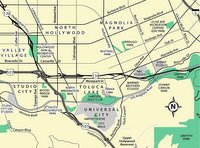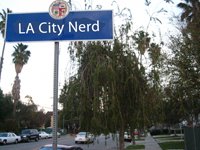 As talked about a lot today in the papers and online, the Universal City Backlot appears to be headed for development. This second attempt at development in the last 5 years means that the community knows how to organize. And, with the advent of Neighborhood Councils since that last "conversation" about expansion, NBC-Universal is going to have quite a time reaching comprise and gaining approval. The approval has to come from both the City and County, eerily similar to that other City/County issue at the other corner of the Valley: Sunshine Canyon Landfill. That means Zev Yaroslavsky and Tom LaBonge have to give their stamp of approval, basically, in order for the project to proceed. Will either stand up to the truly gargantuan Universal? (They don't call it Universal City because it's small!) The main issue with the community is infrastructure: sewers, waterlines, and mostly transportation (i.e. increased traffic!).
As talked about a lot today in the papers and online, the Universal City Backlot appears to be headed for development. This second attempt at development in the last 5 years means that the community knows how to organize. And, with the advent of Neighborhood Councils since that last "conversation" about expansion, NBC-Universal is going to have quite a time reaching comprise and gaining approval. The approval has to come from both the City and County, eerily similar to that other City/County issue at the other corner of the Valley: Sunshine Canyon Landfill. That means Zev Yaroslavsky and Tom LaBonge have to give their stamp of approval, basically, in order for the project to proceed. Will either stand up to the truly gargantuan Universal? (They don't call it Universal City because it's small!) The main issue with the community is infrastructure: sewers, waterlines, and mostly transportation (i.e. increased traffic!).Some interesting points...
First, if you go to the Basement Level of the Museum of Natural History in Exposition Park (originally, you know, it was called "Agricultural Park"), you will find a whole display case next to a model of Downtown L.A. in the 1930s that is full of Universal City paraphernalia. This is where the artifacts revealing Universal "City's" first female Chief of Police confirm her existence as a fake officer.
Ok, that was interesting and quite City Nerd-like; but more relative is this:
A. In 1993, Barham Boulevard & Forest Lawn Drive, which will be main arteries if the backlot is developed, were designated "Congestion Management Program" routes based on the "Land Use Analysis Program". Basically, this meant that in order to comply with State Law and prevent the State Controller from withholding gas tax funds from the County, the local jurisdiction (L.A.) had to create plans that managed traffic in areas that were impacted by land use decisions. To quote, they had to be in compliance by "adopting and implementing a trip reduction and travel demand ordinance; [and by] adopting and implementing a program to analyze the impacts of local land use decisions on the regional transportation system." The ordinance's implication is for NON-residential development. (No mention of mixed-use, though.) The result may not be as intended 13 years ago; will a bulletin board really help? The text of what's required on these routes are here
B. Just a short 11 years ago in 1995, after spending $65,000 on continued studies (with the City of Burbank, the County, and the major private stakeholders: Disney, Universal, NBC, & Warner Bros.) in 1992 to come up with a project, the City of L.A. established a Community Advisory Committee "that includes representatives from surrounding homeowner associations, individual residents, businesses, civic organizations and concerned citizens in all jurisdictions participating in the Phase III project." This Phase III project was funded from the County at $1.2 million with a match from LA of $100K
C. Talks of dealing with traffic in the area of Barham started as early as 1981, with an agreement between L.A. and Burbank in 1977 that called for no development west of Olive until the traffic issues of the Barham Corridor were addressed.
D. In 1994, Burbank's transportation administrator, William Lundgren, said:
"The freeway itself is a source of problems because it doesn't connect well to the (Ventura Freeway) and spills a lot of traffic onto this corridor, traffic it wasn't meant to carry." Gridlock, he said, "would continue until the travel time on those streets is greater than on the freeway, and people would take the freeway again."
E. Finally, and quite ironically, it was then-City Manager Bud Ovrom - who now is L.A. City's Economic Development Czar - who said in 1988, "[Burbank] doesn't see any point for us to get involved in this, because we are already far down the road in implementing permanent controls. "Those permanent controls will be much more restrictive than any temporary measures Los Angeles is talking about." Well, now he's in L.A., and as Deputy Mayor of Economic Development, he'll have to advise the mayor on how to deal what could be quite a large issue for this regional transportation corridor.
So, what we learn from this: things never go away unless they are truly addressed. You know the conversation of the missing connector between the 101 north and the 134 east will be brought up again - and the even more recurring conversation of "how to pay for it."


No comments:
Post a Comment